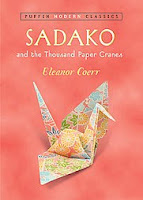First published in 1977, Sadako and the Thousand Paper Cranes is the fictionalized true story of an eleven-year-old Japanese girl with fallout-induced leukemia who became famous throughout Japan for her campaign to fold one thousand origami (folded paper) cranes in a quest to seek the favor of the gods and become healthy again. Her inspirational story was immortalized in a collection of her letters and journal entries that was published in Japan, and today a statue commemorating her life--and her paper cranes--stands in Hiroshima Peace Park, a vivid reminder of the awful consequences of war.
At just 72 pages--17 of which are given over at the end to an epilogue explaining how the author came to write the story, and how to fold origami paper cranes--Sadako is a brisk read, but certainly not a light one. Told in simple and straightforward, yet often lyrical, prose, Coerr pulls no punches in her depictions of Sadako's and other children's illnesses. But while the book is certainly gut-wrenching, it is by no means so graphic that it cannot be read by (or to) children younger than its recommended eight and up age level. (I am, in fact, reading it to seven year old Jo in preparation for our upcoming trip to Japan.) This is one of those rare books where "eight and up" can really mean any age, up or down, not just "eight to twelve."
More than thirty years on, Sadako and the Thousand Paper Cranes is still one of the most powerful, accessible, and important stories we have about the catastrophic effects of nuclear war.
The Sadako Memorial at Hiroshima's Peace Park



No comments:
Post a Comment
Hello! Thanks for dropping by our blog. Feel free to agree or disagree with us, or just chime in with moral support. We leave most everything, but we of course reserve the right to delete anything that's needlessly nasty, profane, or spam. Now, if you'll just insert your two cents into the slot below...
Note: Only a member of this blog may post a comment.